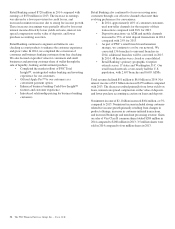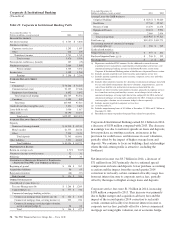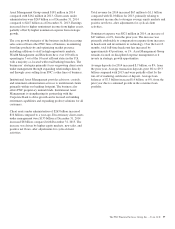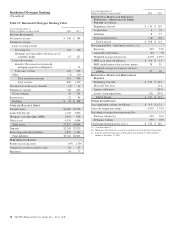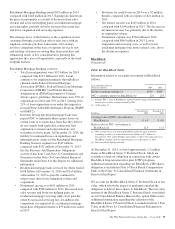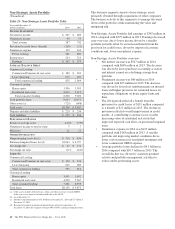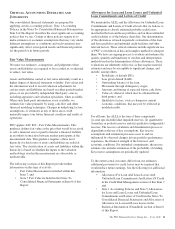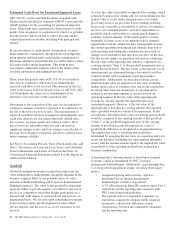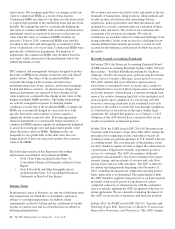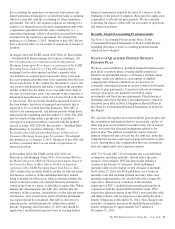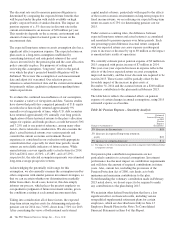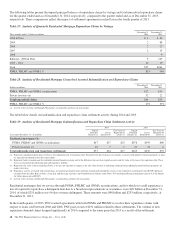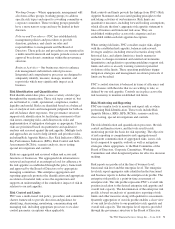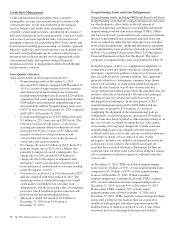PNC Bank 2014 Annual Report Download - page 80
Download and view the complete annual report
Please find page 80 of the 2014 PNC Bank annual report below. You can navigate through the pages in the report by either clicking on the pages listed below, or by using the keyword search tool below to find specific information within the annual report.
Estimated Cash Flows On Purchased Impaired Loans
ASC 310-30 – Loans and Debt Securities Acquired with
Deteriorated Credit Quality (formerly SOP 03-3) provides the
GAAP guidance for the accounting for purchased impaired
loans. These loans have experienced a deterioration of credit
quality from origination to acquisition for which it is probable
that the investor will be unable to collect all contractually
required payments receivable, including both principal and
interest.
In our assessment of credit quality deterioration, we must
make numerous assumptions, interpretations and judgments,
using internal and third-party credit quality information to
determine whether it is probable that we will be able to collect
all contractually required payments. This point in time
assessment is inherently subjective due to the nature of the
available information and judgment involved.
Those loans that qualify under ASC 310-30 are recorded at
fair value at acquisition, which involves estimating the
expected cash flows to be received. Measurement of the fair
value of the loan is based on the provisions of ASC 820. ASC
310-30 prohibits the carryover or establishment of an
allowance for loan losses on the acquisition date.
Subsequent to the acquisition of the loan, we are required to
continue to estimate cash flows expected to be collected over
the life of the loan (or pool of loans). The measurement of
expected cash flows involves assumptions and judgments as to
credit risk, interest rate risk, prepayment risk, default rates,
loss severity, payment speeds and collateral values. All of
these factors are inherently subjective and can result in
significant changes in the cash flow estimates over the life of
the loan. Such changes in expected cash flows could increase
future earnings volatility.
See Note 1 Accounting Policies, Note 4 Purchased Loans, and
Note 5 Allowances for Loan and Lease Losses and Unfunded
Loan Commitments and Letters of Credit in the Notes To
Consolidated Financial Statements in Item 8 of this Report for
additional information.
Goodwill
Goodwill arising from business acquisitions represents the
value attributable to unidentifiable intangible elements in the
business acquired. Most of our goodwill relates to value
inherent in the Retail Banking and Corporate & Institutional
Banking businesses. The value of this goodwill is dependent
upon our ability to provide quality, cost-effective services in
the face of competition from other market participants on a
national and, with respect to some products and services, an
international basis. We also rely upon continuing investments
in processing systems, the development of value-added
service features, and the ease of access by customers to our
services.
As such, the value of goodwill is supported by earnings, which
is driven by transaction volume and, for certain businesses, the
market value of assets under administration or for which
processing services are provided. Lower earnings resulting
from a lack of growth or our inability to deliver cost-effective
services over sustained periods can lead to impairment of
goodwill, which could result in a current period charge to
earnings. At least annually, in the fourth quarter, or more
frequently if events occur or circumstances have changed
significantly from the annual test date, management reviews
the current operating environment and strategic direction of
each reporting unit taking into consideration any events or
changes in circumstances that may have an effect on the unit.
For this review, inputs are generated and used in calculating
the fair value of the reporting unit, which is compared to its
carrying amount (“Step 1” of the goodwill impairment test) as
further discussed below. The fair values of the majority of our
reporting units are determined using a discounted cash flow
valuation model with assumptions based upon market
comparables. Additionally, we may also evaluate certain
financial metrics that are indicative of fair value, including
market quotes, price to earnings ratios and recent acquisitions
involving other financial institutions. A reporting unit is
defined as an operating segment or one level below an
operating segment. If the fair value of the reporting unit
exceeds its carrying amount, the reporting unit is not
considered impaired. However, if the fair value of the
reporting unit is less than its carrying amount, the reporting
unit’s goodwill would be evaluated for impairment. In this
circumstance, the implied fair value of reporting unit goodwill
would be compared to the carrying amount of that goodwill
(“Step 2” of the goodwill impairment test). If the carrying
amount of goodwill exceeds the implied fair value of
goodwill, the difference is recognized as an impairment loss.
The implied fair value of reporting unit goodwill is
determined by assigning the fair value of a reporting unit to its
assets and liabilities (including any unrecognized intangible
assets) with the residual amount equal to the implied fair value
of goodwill as if the reporting unit had been acquired in a
business combination.
A reporting unit’s carrying amount is based upon assigned
economic capital as determined by PNC’s internal
management methodologies. Additionally, in performing Step
1 of our goodwill impairment testing, we utilize three equity
metrics:
• Assigned reporting unit economic capital as
determined by our internal management
methodologies, inclusive of goodwill.
• A 7% fully phased-in Basel III common equity Tier 1
capital ratio for the reporting unit consistent with
PNC’s risk framework guidelines.
• The capital levels for comparable companies (as
reported in comparable company public financial
statements), adjusted for differences in risk
characteristics between the comparable companies
and the reporting unit.
62 The PNC Financial Services Group, Inc. – Form 10-K


